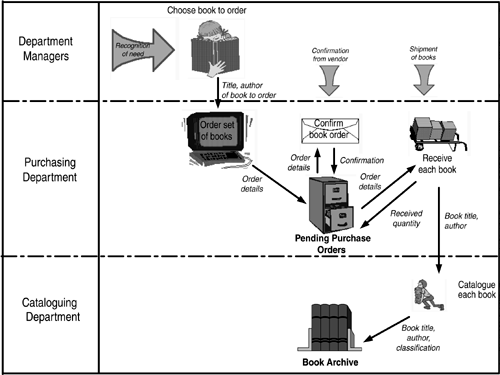A Word About Business Process Re-engineering
A Word About Business Process Re-engineering From the outset it was clear that documenting an enterprise's data flows could be more useful to the company than just as the basis for designing new systems. Why is it necessary to produce 15 copies of a production order in the course of producing a lot? Perhaps there are things that we could do to improve the structure of processes, before we even look into automating some of them. Indeed, some of the processes we thought we were going to automate may be completely eliminated. In the 1990s this recognition took formal shape with the advent of business-process engineering . Suddenly a whole branch of consulting began to specialize in drawing variations on data flow diagrams for the purpose of recommending changes to the structure and processes of an organization. The business process diagram was developed to address this. Business Process DiagramsThe business-process re-engineering movement has come up with the business process diagram . This has been presented as a new technique, but it really is the data flow diagram in new clothes. Like a data flow diagram, it is a set of boxes representing things the company does, linked by data flows and ( optionally ) material flows. It is similar to the approach taken in the UML activity diagram, in that the activities are grouped according to who does them. A business process diagram differs from a data flow diagram in two ways: First, as typically drawn, a business process diagram focuses on the current physical system, with an interest in moving to a new physical system as quickly as possible. The step of looking at the underlying functions, independent of technology, may be overlooked, although processes may be categorized as being "value added" to the extent that they do contribute to the functions of the organization. The current physical nature of the diagrams is emphasized by the replacement, in many cases, of the boxes with icons representing manufacturing, the telephone, forms, and so on. The secondand more significantdifference is that the processes are organized by the players. That is, as with UML activity diagrams, each participant is designated as being responsible for a swim lane , and all processes performed by that participant are shown in that swim lane. (Unlike the UML activity diagram, however, the swim lanes here are horizontal.) An example is shown in Figure 4.25. Figure 4.25. Business Process Diagram. One way to enrich any of the diagrams described here is to highlight the processes that really do contribute to the functions of the business. To do this, produce an essential data flow diagram and compare it to the physical business process diagram. Which of the business process diagram processes directly implement fundamental essential processes? Color those green. Which processes are custodial ? Color those yellow. Which processes are left over and do not contribute to the value of the firm? Color those red. This is a very useful exercise. With each category shaded a different color, you can then determine how best to eliminate the processes that are not of value to the enterprise. |
| | |
| Team-Fly |
| Top |
EAN: 2147483647
Pages: 129

